Risk Assessment in Cloud Services: VideoDev and Cloud Implementation
VerifiedAdded on 2022/10/18
|5
|1151
|26
Report
AI Summary
This report assesses the risks associated with implementing cloud services for VideoDev, a video and production development company. It identifies key threats such as unauthorized access, network dependency, data security breaches, and privacy violations. The report examines the vulnerabilities of cloud-based data storage and the potential for malicious attacks from both external hackers and internal threats. It explores the importance of implementing robust security plans, restricting data access, and utilizing technologies like AI and biometrics for authentication. The report also emphasizes the need for choosing the appropriate cloud model and encrypting data to protect against various attacks. It highlights the significance of staff training and communication in mitigating risks and ensuring the successful adoption of cloud services, referencing relevant literature to support its findings.
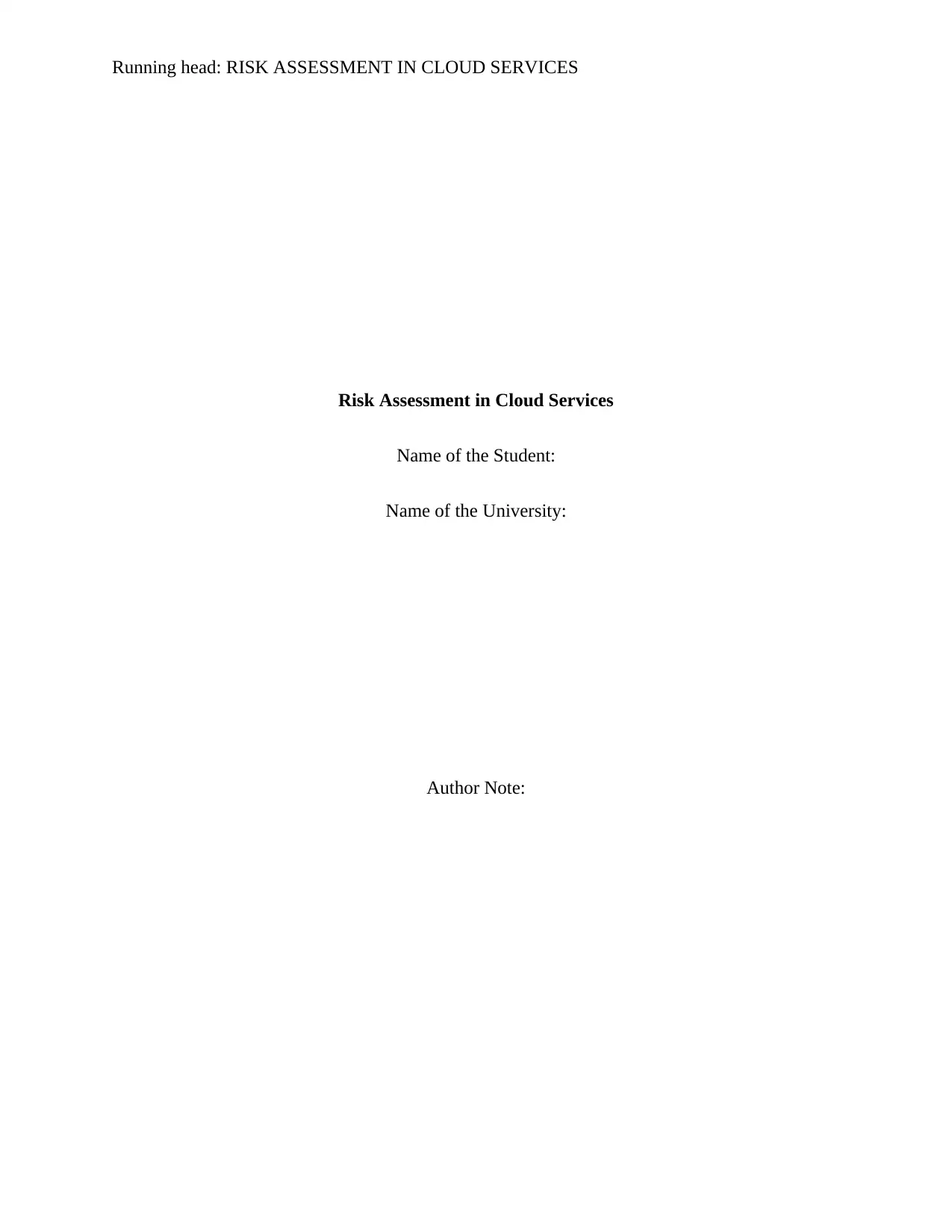
Running head: RISK ASSESSMENT IN CLOUD SERVICES
Risk Assessment in Cloud Services
Name of the Student:
Name of the University:
Author Note:
Risk Assessment in Cloud Services
Name of the Student:
Name of the University:
Author Note:
Paraphrase This Document
Need a fresh take? Get an instant paraphrase of this document with our AI Paraphraser
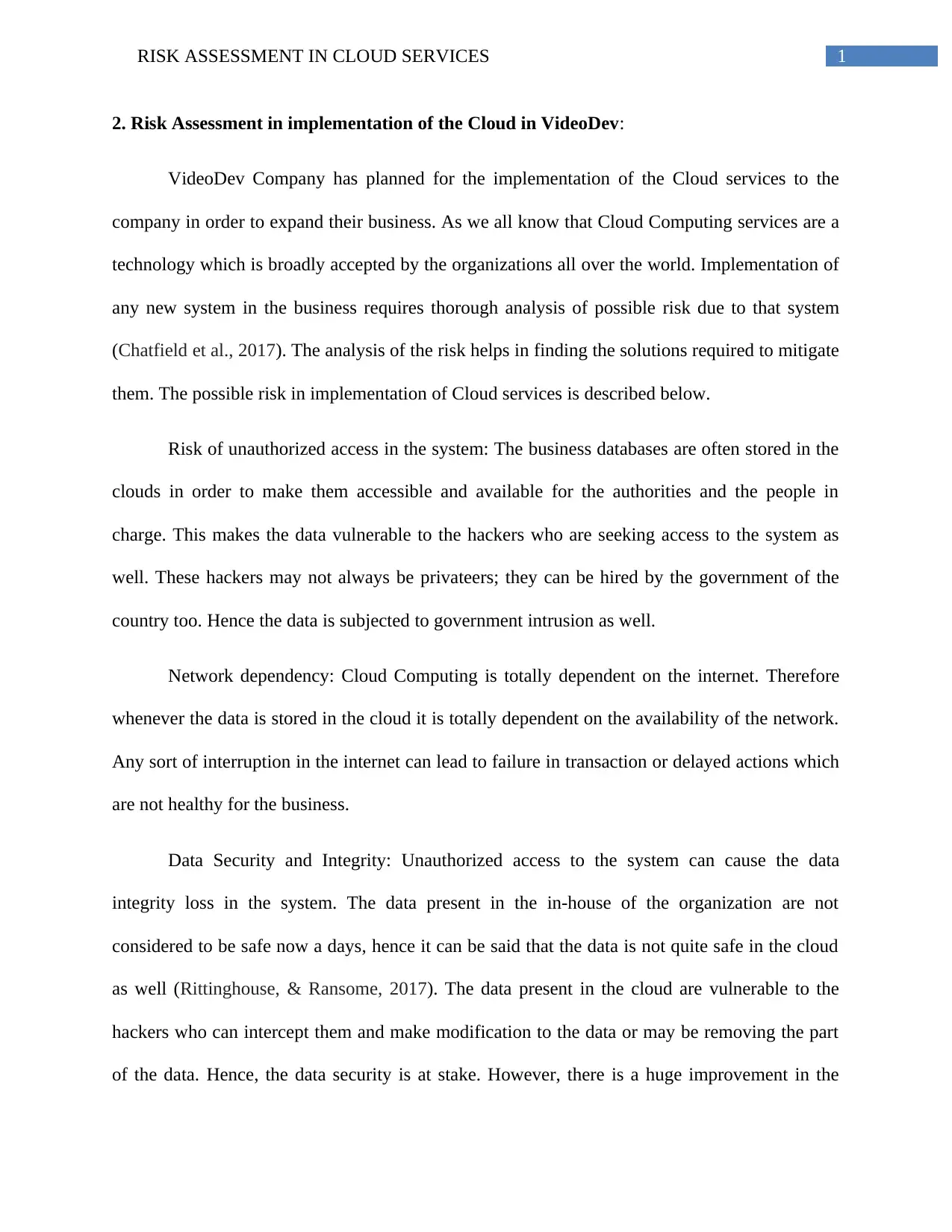
1RISK ASSESSMENT IN CLOUD SERVICES
2. Risk Assessment in implementation of the Cloud in VideoDev:
VideoDev Company has planned for the implementation of the Cloud services to the
company in order to expand their business. As we all know that Cloud Computing services are a
technology which is broadly accepted by the organizations all over the world. Implementation of
any new system in the business requires thorough analysis of possible risk due to that system
(Chatfield et al., 2017). The analysis of the risk helps in finding the solutions required to mitigate
them. The possible risk in implementation of Cloud services is described below.
Risk of unauthorized access in the system: The business databases are often stored in the
clouds in order to make them accessible and available for the authorities and the people in
charge. This makes the data vulnerable to the hackers who are seeking access to the system as
well. These hackers may not always be privateers; they can be hired by the government of the
country too. Hence the data is subjected to government intrusion as well.
Network dependency: Cloud Computing is totally dependent on the internet. Therefore
whenever the data is stored in the cloud it is totally dependent on the availability of the network.
Any sort of interruption in the internet can lead to failure in transaction or delayed actions which
are not healthy for the business.
Data Security and Integrity: Unauthorized access to the system can cause the data
integrity loss in the system. The data present in the in-house of the organization are not
considered to be safe now a days, hence it can be said that the data is not quite safe in the cloud
as well (Rittinghouse, & Ransome, 2017). The data present in the cloud are vulnerable to the
hackers who can intercept them and make modification to the data or may be removing the part
of the data. Hence, the data security is at stake. However, there is a huge improvement in the
2. Risk Assessment in implementation of the Cloud in VideoDev:
VideoDev Company has planned for the implementation of the Cloud services to the
company in order to expand their business. As we all know that Cloud Computing services are a
technology which is broadly accepted by the organizations all over the world. Implementation of
any new system in the business requires thorough analysis of possible risk due to that system
(Chatfield et al., 2017). The analysis of the risk helps in finding the solutions required to mitigate
them. The possible risk in implementation of Cloud services is described below.
Risk of unauthorized access in the system: The business databases are often stored in the
clouds in order to make them accessible and available for the authorities and the people in
charge. This makes the data vulnerable to the hackers who are seeking access to the system as
well. These hackers may not always be privateers; they can be hired by the government of the
country too. Hence the data is subjected to government intrusion as well.
Network dependency: Cloud Computing is totally dependent on the internet. Therefore
whenever the data is stored in the cloud it is totally dependent on the availability of the network.
Any sort of interruption in the internet can lead to failure in transaction or delayed actions which
are not healthy for the business.
Data Security and Integrity: Unauthorized access to the system can cause the data
integrity loss in the system. The data present in the in-house of the organization are not
considered to be safe now a days, hence it can be said that the data is not quite safe in the cloud
as well (Rittinghouse, & Ransome, 2017). The data present in the cloud are vulnerable to the
hackers who can intercept them and make modification to the data or may be removing the part
of the data. Hence, the data security is at stake. However, there is a huge improvement in the
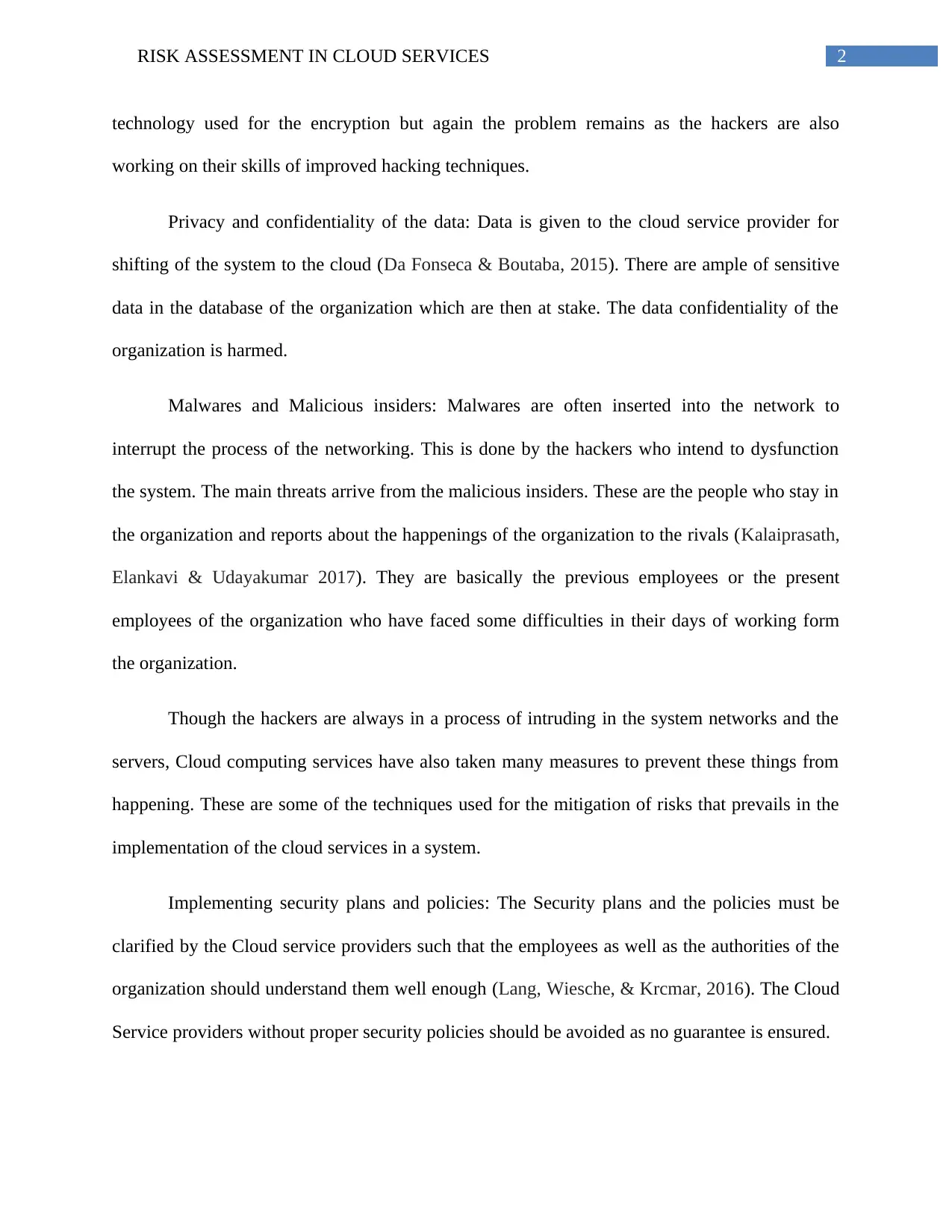
2RISK ASSESSMENT IN CLOUD SERVICES
technology used for the encryption but again the problem remains as the hackers are also
working on their skills of improved hacking techniques.
Privacy and confidentiality of the data: Data is given to the cloud service provider for
shifting of the system to the cloud (Da Fonseca & Boutaba, 2015). There are ample of sensitive
data in the database of the organization which are then at stake. The data confidentiality of the
organization is harmed.
Malwares and Malicious insiders: Malwares are often inserted into the network to
interrupt the process of the networking. This is done by the hackers who intend to dysfunction
the system. The main threats arrive from the malicious insiders. These are the people who stay in
the organization and reports about the happenings of the organization to the rivals (Kalaiprasath,
Elankavi & Udayakumar 2017). They are basically the previous employees or the present
employees of the organization who have faced some difficulties in their days of working form
the organization.
Though the hackers are always in a process of intruding in the system networks and the
servers, Cloud computing services have also taken many measures to prevent these things from
happening. These are some of the techniques used for the mitigation of risks that prevails in the
implementation of the cloud services in a system.
Implementing security plans and policies: The Security plans and the policies must be
clarified by the Cloud service providers such that the employees as well as the authorities of the
organization should understand them well enough (Lang, Wiesche, & Krcmar, 2016). The Cloud
Service providers without proper security policies should be avoided as no guarantee is ensured.
technology used for the encryption but again the problem remains as the hackers are also
working on their skills of improved hacking techniques.
Privacy and confidentiality of the data: Data is given to the cloud service provider for
shifting of the system to the cloud (Da Fonseca & Boutaba, 2015). There are ample of sensitive
data in the database of the organization which are then at stake. The data confidentiality of the
organization is harmed.
Malwares and Malicious insiders: Malwares are often inserted into the network to
interrupt the process of the networking. This is done by the hackers who intend to dysfunction
the system. The main threats arrive from the malicious insiders. These are the people who stay in
the organization and reports about the happenings of the organization to the rivals (Kalaiprasath,
Elankavi & Udayakumar 2017). They are basically the previous employees or the present
employees of the organization who have faced some difficulties in their days of working form
the organization.
Though the hackers are always in a process of intruding in the system networks and the
servers, Cloud computing services have also taken many measures to prevent these things from
happening. These are some of the techniques used for the mitigation of risks that prevails in the
implementation of the cloud services in a system.
Implementing security plans and policies: The Security plans and the policies must be
clarified by the Cloud service providers such that the employees as well as the authorities of the
organization should understand them well enough (Lang, Wiesche, & Krcmar, 2016). The Cloud
Service providers without proper security policies should be avoided as no guarantee is ensured.
⊘ This is a preview!⊘
Do you want full access?
Subscribe today to unlock all pages.

Trusted by 1+ million students worldwide
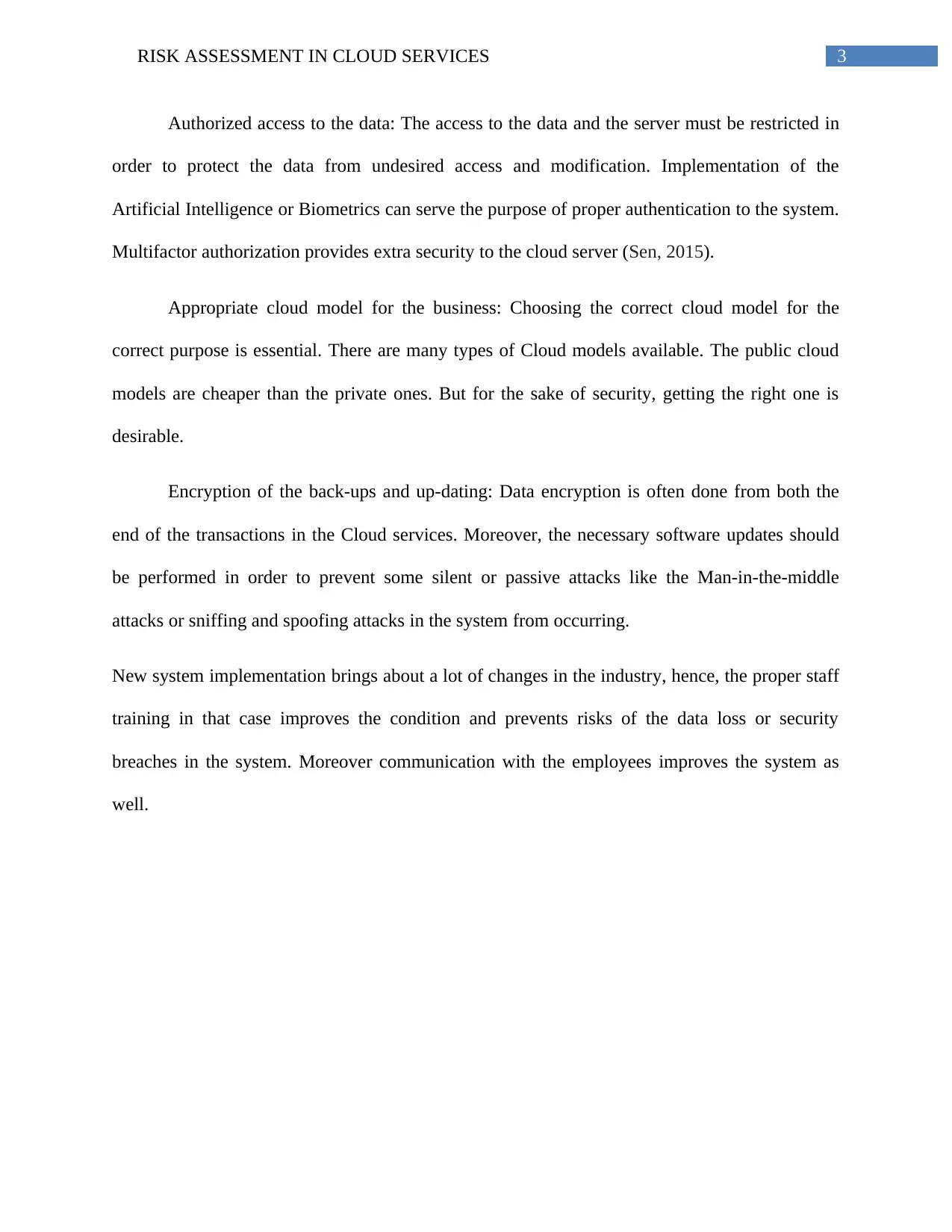
3RISK ASSESSMENT IN CLOUD SERVICES
Authorized access to the data: The access to the data and the server must be restricted in
order to protect the data from undesired access and modification. Implementation of the
Artificial Intelligence or Biometrics can serve the purpose of proper authentication to the system.
Multifactor authorization provides extra security to the cloud server (Sen, 2015).
Appropriate cloud model for the business: Choosing the correct cloud model for the
correct purpose is essential. There are many types of Cloud models available. The public cloud
models are cheaper than the private ones. But for the sake of security, getting the right one is
desirable.
Encryption of the back-ups and up-dating: Data encryption is often done from both the
end of the transactions in the Cloud services. Moreover, the necessary software updates should
be performed in order to prevent some silent or passive attacks like the Man-in-the-middle
attacks or sniffing and spoofing attacks in the system from occurring.
New system implementation brings about a lot of changes in the industry, hence, the proper staff
training in that case improves the condition and prevents risks of the data loss or security
breaches in the system. Moreover communication with the employees improves the system as
well.
Authorized access to the data: The access to the data and the server must be restricted in
order to protect the data from undesired access and modification. Implementation of the
Artificial Intelligence or Biometrics can serve the purpose of proper authentication to the system.
Multifactor authorization provides extra security to the cloud server (Sen, 2015).
Appropriate cloud model for the business: Choosing the correct cloud model for the
correct purpose is essential. There are many types of Cloud models available. The public cloud
models are cheaper than the private ones. But for the sake of security, getting the right one is
desirable.
Encryption of the back-ups and up-dating: Data encryption is often done from both the
end of the transactions in the Cloud services. Moreover, the necessary software updates should
be performed in order to prevent some silent or passive attacks like the Man-in-the-middle
attacks or sniffing and spoofing attacks in the system from occurring.
New system implementation brings about a lot of changes in the industry, hence, the proper staff
training in that case improves the condition and prevents risks of the data loss or security
breaches in the system. Moreover communication with the employees improves the system as
well.
Paraphrase This Document
Need a fresh take? Get an instant paraphrase of this document with our AI Paraphraser
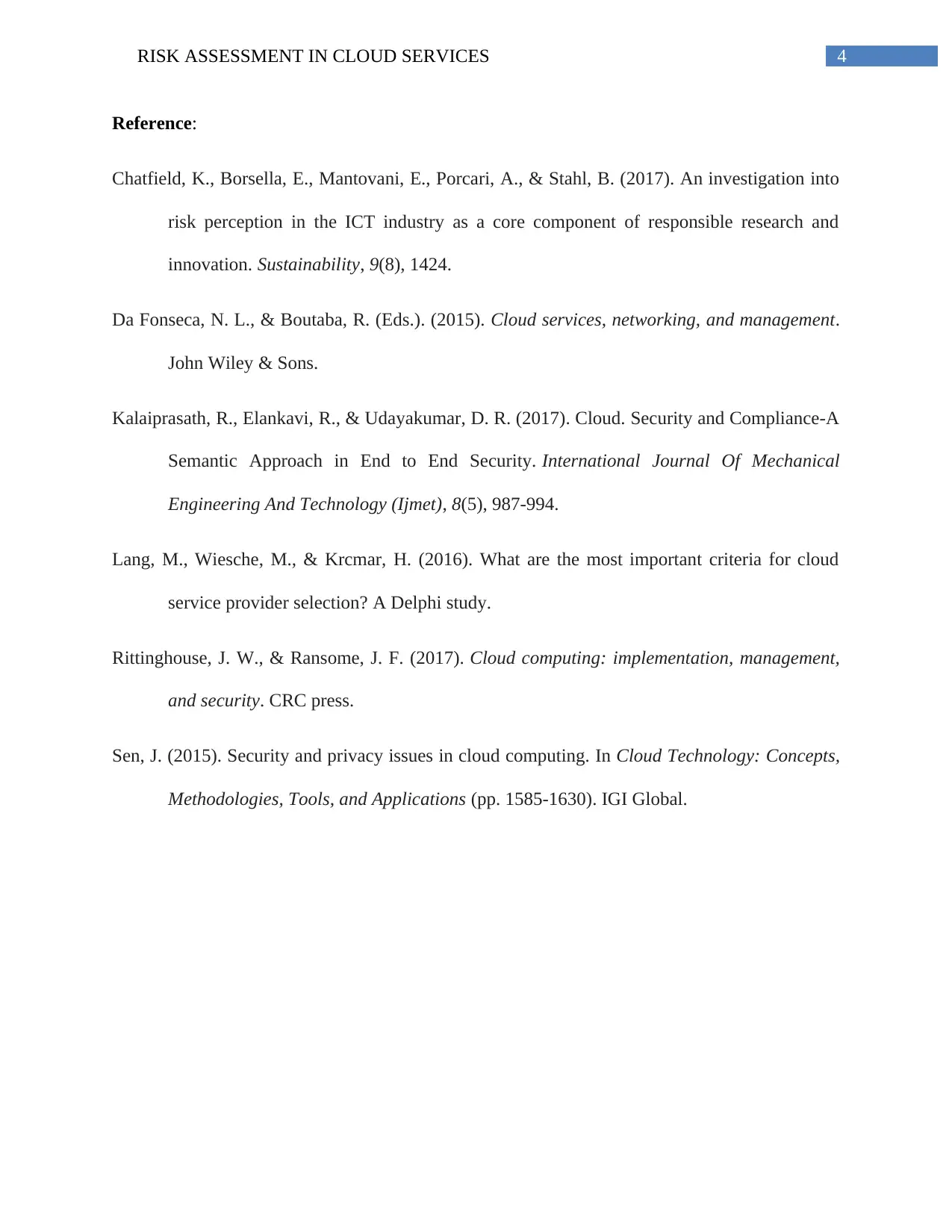
4RISK ASSESSMENT IN CLOUD SERVICES
Reference:
Chatfield, K., Borsella, E., Mantovani, E., Porcari, A., & Stahl, B. (2017). An investigation into
risk perception in the ICT industry as a core component of responsible research and
innovation. Sustainability, 9(8), 1424.
Da Fonseca, N. L., & Boutaba, R. (Eds.). (2015). Cloud services, networking, and management.
John Wiley & Sons.
Kalaiprasath, R., Elankavi, R., & Udayakumar, D. R. (2017). Cloud. Security and Compliance-A
Semantic Approach in End to End Security. International Journal Of Mechanical
Engineering And Technology (Ijmet), 8(5), 987-994.
Lang, M., Wiesche, M., & Krcmar, H. (2016). What are the most important criteria for cloud
service provider selection? A Delphi study.
Rittinghouse, J. W., & Ransome, J. F. (2017). Cloud computing: implementation, management,
and security. CRC press.
Sen, J. (2015). Security and privacy issues in cloud computing. In Cloud Technology: Concepts,
Methodologies, Tools, and Applications (pp. 1585-1630). IGI Global.
Reference:
Chatfield, K., Borsella, E., Mantovani, E., Porcari, A., & Stahl, B. (2017). An investigation into
risk perception in the ICT industry as a core component of responsible research and
innovation. Sustainability, 9(8), 1424.
Da Fonseca, N. L., & Boutaba, R. (Eds.). (2015). Cloud services, networking, and management.
John Wiley & Sons.
Kalaiprasath, R., Elankavi, R., & Udayakumar, D. R. (2017). Cloud. Security and Compliance-A
Semantic Approach in End to End Security. International Journal Of Mechanical
Engineering And Technology (Ijmet), 8(5), 987-994.
Lang, M., Wiesche, M., & Krcmar, H. (2016). What are the most important criteria for cloud
service provider selection? A Delphi study.
Rittinghouse, J. W., & Ransome, J. F. (2017). Cloud computing: implementation, management,
and security. CRC press.
Sen, J. (2015). Security and privacy issues in cloud computing. In Cloud Technology: Concepts,
Methodologies, Tools, and Applications (pp. 1585-1630). IGI Global.
1 out of 5
Related Documents
Your All-in-One AI-Powered Toolkit for Academic Success.
+13062052269
info@desklib.com
Available 24*7 on WhatsApp / Email
![[object Object]](/_next/static/media/star-bottom.7253800d.svg)
Unlock your academic potential
Copyright © 2020–2025 A2Z Services. All Rights Reserved. Developed and managed by ZUCOL.





